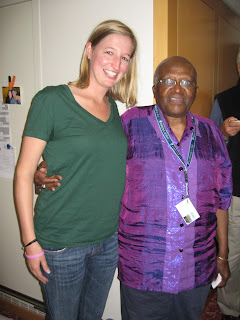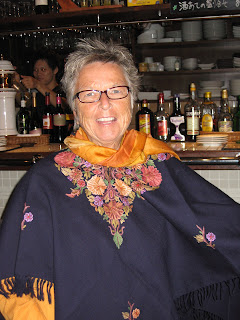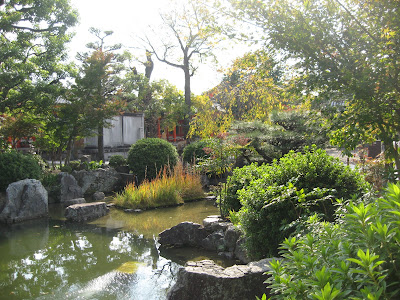October 14, 2010
Mauritius is a small volcanic island country near Madagascar, half the size of Rhode Island. When ships began sailing the Indian Ocean in search of goods to trade and food to eat, they found Mauritius. Historical artifacts indicate that Arab merchants were the first to inhabit this island. Like most countries we are visiting on this voyage, many levels of income are represented. But unlike the world, Mauritius has been in an economic boom for the last 10 years. Unemployment has been reduced from 20% to just 3%. Sixty percent of the citizens belong to the middle class. New construction is everywhere, but most homes are unfinished and/or unpainted in an effort to avoid taxes! Now this makes for a pretty unattractive drive through the towns. And, according to the National Geographic, most of the growth occurred without planning! Amazing!
 |
| Mauritius |
 One forgotten plan was how to manage the traffic that comes with growth. Much of getting around the island is like getting around Lake of the Ozarks or Table Rock Lake. All beaches are public, but the fancy resorts on the east side of the island discourage “riffraff” from their beaches . The slow traffic allowed us to see more while on our way to the lovely beaches or the pretty gardens.
One forgotten plan was how to manage the traffic that comes with growth. Much of getting around the island is like getting around Lake of the Ozarks or Table Rock Lake. All beaches are public, but the fancy resorts on the east side of the island discourage “riffraff” from their beaches . The slow traffic allowed us to see more while on our way to the lovely beaches or the pretty gardens.The chief industry is sugar (so they make rum!), tea, financial services and tourism. tourism is really growing. They cater to Europeans.
The country was first settled by Arabs, then Dutch, French, and eventually, British. Slaves were brought from Africa and indentured workers from India. Somehow, I forgot how, the Chinese came. The population today is 3.5 million and composed of 48% Hindi and 17% Muslim from India; 27% are mixed Africans or Creoles; the Chinese constitute 3% and the French, 2%. This wonderful mix of people makes for a wonderful mix of cuisines and religious celebrations. The Mauritians celebrate each other’s holidays including Christmas. Mosques, churches, and Tamil and Hindi temples abound. We did see a couple of Buddhist temples also. And “spirit” houses or small shrines of the various religions stood outside many homes along the route we traveled. One was even built like a cave, underground.
 |
| This is a shrine in someone's yard |
 |
| A shrine in a cave along the highway |
The Botanical Garden was very beautiful and unlike any we have seen. In fact, it could be called an arboretum because the only flowers were in trees and on the water lilies and lotus ponds. Many varieties of palms I’d not seen before grow in Mauritius, but few indigenous plants are represented. Most everything came from other tropical places.
 | <><><><>
| Eleven LLL's surround the Balboa tree! |
Our catamaran trip was from a small village. Paul can tell you about that trip. We had a great time.
A blog from Paul
Oh, I guess I am supposed to tell you more. Three catamarans were reserved. Two were primarily for the students. Ours was primarily for the ten of us aged Life Long Learners and ten students who couldn’t get on the other boats. Everyone mixed very well however – laughing and having lots of fun. Fortunately or unfortunately depending on your point of view, no alcohol was available on the boat because last year the students got smashed and apparently ruined it for everyone else. The crew provided various soda drinks and water except one aged man (ME) who was given a beer in the galley but told to keep it secret. I was entertaining to them so they wanted to give me some rum and more beer but being a man of SELF-CONTROL I politely declined. Ha!
The weather was ideal – in the mid 80’s with a slight cool breeze. Most of us snorkeled on the coral reefs which was really exciting. However, according to my Marine Biology professor, there is no legal regulation on the reefs and thus fishing companies catch most of the fish with nets and even dynamite. When there are fewer fish around the reefs, he said that the reefs are coated with algae making them unattractive and unhealthy. However, we did see some beautiful fish like angel and parrot fish. – Suzanne compared it to Hawaii. Winston and Cynthia, Suzanne’s sister and brother-in-law, spoiled us a few years ago with snorkeling in the British Virgin Islands. Nothing compares to those bright colored fish and crystal clear blue water. The food on the catamaran was great with various salads, grilled chicken and grilled marlin. It was a full day trip and most of us were pretty tired when we returned except, of course, Suzanne.
 |
| This Dove church was built in someone's memory. |
There is a strict policy on the ship that all students must be on board by 6:00PM or they will be docked 15 minutes for every minute they are late. For example, if you are 15 minutes late you will be docked 3 hours at the next port, 30 minutes late, 6hours . One student at the beginning of our voyage was an hour and a half late. He had drinking at a local bar and was docked 17 hours! When docked means you cannot get off the ship at the next port until your penalty is met. No exceptions! The real problem occurs when you have paid for an expensive field trip at the next port and your dock time exceeds the departure - you lose the trip and your money! The ship always departs as scheduled at 8:00PM. If you are not on board –tough – they leave without you! Then, if you want to continue, you must fly to the next port at your own expense and likely be docked severely. The students are told constantly not to wait till the last minute to return to the ship since a long line exists at that point to get back on the ship. They risk not making it on time and dock time. So this last departure from Mauritius, there was approximately 80 students standing in line and all were docked accordingly. They were not happy students. We are now in route to Chennai, India where Suzanne will be in heaven going on a three day Art of Living and Dakshinachitra Heritage stay learning Indian Yoga, breathing and meditation. I have signed up to learn Tai Chi in Hong Kong and will be glad to demonstrate to you all for a large FEE if you are interested when I return. Ha.












































